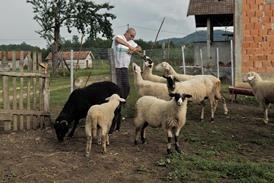Fresh from the successful limited release of Bully in the US, director Lee Hirsch talks to Screen about his childhood battle with bullying, the filming of his documentary and the ratings fight with the MPAA.
The character-driven documentary (which premiered at Tribeca 2011 with the title The Bully Project) offers a look at how bullying has touched the lives of children and their families. The MPAA originally gave Bully an R rating due to language used in parts of the film. The Weinstein Company appealed and decided to release it unrated on March 30.
You experienced bullying as a child, can you tell me how that influenced you to make a film about bullying?
It’s funny. As much press as I have done it’s not easy to talk about. I was bullied for many years. The take-away was how hard it was to communicate the extent to which it was terrifying and violent. I think that there are lots of things that inspired the film, but one of them was to sort of show what happens and to give that voice to people that have been through that or are going through it. That very much is a part of what was the inspiration to do the film.
Of all the research you have done for the film and after actually finishing filming, did you learn anything that surprised you about bullying in today’s day and age?
No, I wasn’t surprised. I would say that the need for people to talk about this has been overwhelming and surprising in a way. How people are still connected with this is surprising. [And yet] I was surprised by how much indifference there could be; how hard that wall could be to climb for folks. It has been a very emotional ride and journey.
What were the challenges in filming the doc?
Independent films are very hard. It’s hard to raise money. In a way I am so grateful for the Tribeca Film Festival for our launch and with The Weinstein Company for picking it up because there are so many great films and filmmakers. You just never know what will happen with your movies. So it’s been a real journey and we are just fortunate to have this opportunity.
How were you able to finance the film?
We had some great partners that include The Waitt Institute for Violence Prevention, Sundance Institute, the Fledgling Fund and many others. We’ve had incredible funders the whole way through.
How did you choose the school district and the main characters for the film?
We reached out to a number and then the conversation didn’t go very far. We were introduced to the school system by the Waitt Institute for Violence Prevention and they have been incredible supporters. Once we engaged in the conversation with the city, the school board and superintendent, it was the sort of the break for us that we needed to make the film. It was extraordinary for them to agree and have that kind of access and that kind of editorial control. We are very grateful to them.
How did the school district react to what they saw in the film?
I think it’s been a real journey for them and for all of us. We did a community screening there and we thought maybe 400 people would show up, but actually1,600 came. There was an incredible community conversation afterwards. The leadership of the district and Kim Lockwood was there. It was very powerful and I’m sure this was difficult for them and I’m very appreciative of them.
Do you know if the school has changed its policies about how it is dealing with the bullying issue?
I know they radically changed their policies with the busing system. They put in more cameras and they have more people reviewing them. The thing about their school district was that they were already in the process of transformation. Choosing to let us make this film was letting us to be a part of the piece in the journey. It’s hard to move a whole district. We filmed in the school that had a wonderful climate. It’s a building-by-building journey.
Did you ever consider including the voice of the bully in the film?
I did, but ultimately I felt the heart and soul of the film was just being with the family and the kids that deal with it. That was a directorial choice.
The Weinstein Company decided to release the film unrated, do you think that was the right decision?
I do. At the end of the day, that R rating was totally restrictive and unwarranted. We had so much encouragement and support from the 520,000 that signed the petition, from members of Congress to incredible celebrities. We just couldn’t take that rating. It was great to have the support of The Weinstein Company to be willing to release this unrated. Extraordinary beyond that was to see so many exhibitors making their own decisions and approaching this in a really intelligent and positive way. I’m really thankful to everyone to how this was handled, except for the MPAA.
In Canada they decided to release the film with a PG-13 rating, am I correct?
You are. We are PG-13 across all the provinces in Canada except for Quebec where we are rated G. It was wonderful because I just literally got back from Toronto today, where we are opening the film on Friday. I got to talk to audiences and journalists across Canada and let them know how much energy that gave us. We are in the middle of a fight and we get phone calls that province after province was getting the PG-13 rating.
Do you think that will play a role in the decision here in the US?
I’m still fighting and I’m still hoping that there will be a resolution as we expand further that the MPAA will give us the PG-13 rating we are advocating for. I think that there is already change brewing in the MPAA. I just read the LA Times piece on the cover of the calendar section about the changes at the MPAA. That’s really exciting. At this point, the national conversation has been fascinating and it has been very healthy. I think people are questioning the morality judgment that the MPAA [made?]on behalf of the public. They are very clear that they are speaking for Middle America in this decision. I think the middle of America has lifted their voices and said “You are actually not representing us”.
How did the audience in Canada receive the film?
Very well. It’s been great. The Toronto premiere was fantastic. We had the minister of education for Ontario, youth leaders and educators. There was also a town hall afterwards. It was just a wonderful evening.
Why should the public watch the film?
I think the film has the capacity to be transformative and it helps. It gives people a window into something really important and an opportunity for powerful conversation. It’s moving and it’s a strong film just on its own merits. I actually hope people come to it for a variety of reasons. But I know the audience reaction is tremendous.
Do you have any projects set up after you’re done promoting Bully?
I’m looking at feature possibilities. That’s where I would like to stand out creatively and have some fun with my next project and branch out in some narratives.





















1 Readers' comment